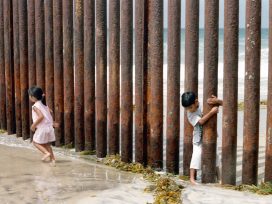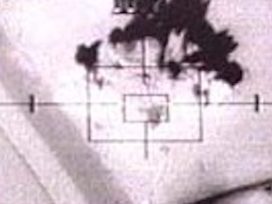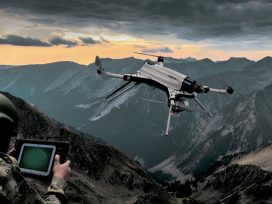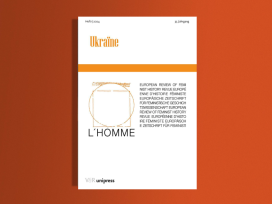Every sphere of life has been penetrated by capital and subjected to quantification. In this context, borders have become nothing other than the violence underlying our world’s order, a war against mobility that is filling Europe with dead bodies and migrant camps. Can we dare to imagine the abolition of borders?
The escalation is undeniable. No sphere of contemporary life has been left untouched by the spread of capital. Admittedly, its penetration is uneven. In many parts of the world, it operates primarily by proxy. Stupefied by poverty, destitution and deprivation, whole classes of people experience first-hand the dissociation between the world as actually lived, the material world of life at a specific place on the Earth’s surface, and the ubiquitous and blissful world of the screen – visible but utterly untouchable, uncontactable, unpossessable.
Nothing seems to escape capital’s control, whether affects, emotions and feelings, linguistic skills, or manifestations of desire, dreams or thought – all of life, in short. Capital extends its grasp deep into the underbelly of the world, leaving in its wake vast fields of debris and toxins, waste heaps of men ravaged by sores, abscesses and boils. Now that everything is a potential source of capitalization, capital has made a world of itself: a hallucinatory phenomenon of planetary dimensions that produces, on a grand scale, subjects who are simultaneously calculating, fictional and delirious.
Capital having been made flesh, everything is now a function of capital, even interiority. The processes driving this universal expansion are erratic. Everywhere they create randomness and uncertainty. Everywhere they institutionalize the risk inherent in the misfortunes of reality. Everywhere they are subject to diversion and solicitation. No matter: capital has become our shared infrastructure, our nervous system, the transcendental maw that maps out our world and its psycho-physical limits.
Digital computation
This world creation process is going on at a time when all societies are organized according to the same guiding principle: digital computation. The term must be understood in three ways. First, as a technical system or mechanical device specialized in the abstraction, and so the capture and automatic processing, of data (material and mental) that must be identified, selected, sorted, classified, recombined and activated. If digitization is a task of abstraction, that task is inseparable from another: calculation – of both the liveable and the thinkable.
The computational is a force that produces and serializes subjects, objects, phenomena, but also consciences and memories and traces, which can be coded and stored and which are capable of circulating. Finally, the computational is the institution through which a common world, a new common sense, and new configurations of reality and power are brought into being and shaped. This world and this common sense result from the fusion of three types of reason, each subject to constant extension and augmentation: economic, biological and algorithmic. These three forms of reason are haunted by a metaphysical phantom: technolatry.
Computational mechanisms, algorithmic modelling and the extension of capital into every sphere of life are all part of one and the same process. Whether operating on bodies, nerves, material, blood, cellular tissue, the brain or energy, the aim is the same: first, the conversion of all substances into quantities – the pre-emptive calculation of possibilities, risks and contingencies with a view to their financialization; second, the conversion of organic and vital ends into technical means. Everything must be detached from any kind of substrate, from all corporeality, from all materiality; everything must be artificialized, automated and autonomized. Everything must be subjected to quantification and abstraction. Digitization is nothing other than this capture of forces and possibilities and their annexation by the language of a machine-brain transformed into an autonomous and automated system.
All this is now driving an unprecedented unification of the planet. The planet itself is increasingly understood and experienced as a universal field of mediations. It is no longer a physical world so much as a reticular one. But this ubiquitous, instantaneous world, populated by connection devices and all sorts of prosthetics, is confronted by another world, the old world of bodies and distances, materials and areas, fractured spaces and borders – the world of separation.
Borderization
Humanity is on the verge of being reborn in a second form thanks to an intrinsic transformation of the horizon of calculation and an almost indefinite expansion of the apparatus of quantification. It may seem paradoxical or counter-intuitive to define this technological moment as entropic. Nevertheless, in many ways it is just that. The actions of capturing, identifying, dividing, sorting, selecting and classifying are not exclusive to artificial machines. They are also performed by borders – those places where, for many of our contemporaries, the world comes undone and globalization comes up against its limits.
The border is no longer simply a line of demarcation separating distinct sovereign entities. An ontological device, it now operates in and of itself, anonymous and impersonal, following its own laws. Increasingly, it is the proper noun we use to name the organized violence underlying contemporary capitalism and our world order in general: the child separated from its parents and shut in a cage, the women and men deemed superfluous and discarded, the hundreds if not thousands of weekly shipwrecks and drownings, the interminable waiting and humiliation in consulates, suspended time, miserable days spent roaming airports, parks, police stations, train stations and city pavements where, as soon as night falls, blankets and rags are torn from the debased bodies of human beings who have already been dispossessed and deprived of almost everything, down to water, hygiene and sleep – in short, humanity in escheat.
Ultimately, all roads lead back to the border, that ground zero of non-relation and denial of the very idea of a shared humanity, of one planet – the only one we have – that we all share and to which we are all bound by our shared itinerant condition. But perhaps, for the sake of accuracy, we should talk of ‘borderization’ rather than borders.
What is ‘borderization’ if not the process by which world powers permanently transform certain spaces into places that are impassable to certain classes of people? What is ‘borderization’ if not the deliberate multiplication of spaces of loss and grief, where so many people, deemed undesirable, see their lives shatter into pieces?
What is it, if not a way to wage war against enemies whose living environments and chances of survival have already been devastated? The use of uranium armour-piercing ammunition and prohibited weapons like white phosphorus; the high-altitude bombardment of basic infrastructure; the cocktail of carcinogenic and radioactive chemical products deposited in the soil and filling the air; the toxic dust raised by the ruins of obliterated towns; the pollution emitted by hydrocarbon fires?
And what about the bombs? Is there any type of bomb that has not been dropped on civilian populations since the last quarter of the twentieth century? Classic dumb bombs repurposed with tail-mounted inertial measurement units; cruise missiles with infrared seekers; microwave bombs designed to paralyze the enemy’s electronic nerve centres; other microwave bombs that do not kill but burn skin; bombs that detonate in cities releasing energy beams like bolts of lightning; thermobaric bombs that unleash walls of fire, suck the oxygen out of more or less confined spaces, send out deadly shockwaves and suffocate anything that breathes; cluster bombs that explode above the ground and scatter small shells, designed to detonate on contact, indiscriminately over a wide area, with devastating consequences for civilian populations; all sorts of bomb, a reductio ad absurdum demonstration of unprecedented destructive power – in short, ecocide.
Under these circumstances, how can we be surprised when those who can, those who have survived living hell, try to escape and seek refuge in any and every corner of Earth where they might be able to live safely?
This form of calculated, programmed war, this war of stupefaction with its new methods, is a war against the very ideas of mobility, circulation and speed, despite the fact that we live in an age of velocity, acceleration and ever more abstraction, ever more algorithms.
Its targets, moreover, are not singular bodies; they are entire human masses who are dismissed as contemptible and superfluous, but whose organs must each suffer their own specific form of incapacitation, with consequences that last for generations – eyes, nose, mouth, ears, tongue, skin, bones, lungs, gut, blood, hands, legs, all the cripples, paralytics, survivors, all the pulmonary diseases like pneumoconiosis, all the traces of uranium found in hair, the thousands of cancers, miscarriages, birth defects, congenital deformities, wrecked thoraxes, nervous system disorders – utter devastation.
All these things, it bears repeating, are connected to contemporary practices of borderization being carried out remotely, far away from us, in the name of our freedom and security. This conflict against specific bodies of abjection, mounds of human flesh, unfolds on a planetary scale. It is poised to become the defining conflict of our time.
Human flesh and the hunt for fugitives
This conflict often precedes, accompanies or supplements the other conflict being waged in our midst or at our doors: the hunt for bodies that have been foolish enough to move (movement being the essential property of the human body); bodies judged to have forced their way into places and spaces where they have no business being, places they clog up by simply existing, and from which they must be expelled.
As the philosopher Elsa Dorlin remarks, this form of violence is directed towards prey. It resembles the great hunts of the past – tracking and pursuing, laying traps and beating, and finally surrounding, capturing or slaughtering the quarry with the help of pack hounds and bloodhounds. It fits into a long history of manhunts. Grégoire Chamayou studies their various manifestations in Manhunts: A Philosophical History. They always involve the same sort of quarry – slaves, aborigines, dark skins, Jews, the stateless, the poor and, closer to home, the undocumented. They target animate, moving bodies that, marked out and ostracized, are seen as entirely different from our own bodies despite being endowed with attractive force, intensity, the capacity to move and flee. These hunts are taking place at a time when technologies of acceleration are proliferating endlessly and creating a segmented, multi-speed planet.
The technologization of borders is in full swing. Physical and virtual barriers, the digitization of databases and record-keeping systems, the development of new tracking devices like sensors, drones, satellites and sentry robots, infrared sensors and various kinds of camera, biometric checks and smart cards that store personal information – all of it is mobilized in order to hasten the arrival of a mobile, portable, omnipresent border.
Confinement and expurgation
Migrants and refugees are not, in themselves, the principal point of disagreement. They have no name of their own, no distinctive face, no identity card. They are no more than hollow crypts, walking vaults containing various organs, empty but threatening shapes that serve to entomb the fantasies of an era terrified of itself and its own excesses. The dream of watertight security – which requires not just systematic and total surveillance but also expurgation – is symptomatic of the structural tensions that for decades have gone hand in hand with our move towards a more automated, reticular and abstract screen-based technical system – digital, algorithmic, numinous.
The world no longer reveals itself to us in the same terms as before. What we are witnessing is the birth of a new form of human (subject/object) and alternative forms of spatiality. Our phenomenological experience of the world is being profoundly shaken. Reason and perception no longer coincide. Hence the panic.
We see less and less of what is there for us to see and more and more of what we desperately want to see, even though what we want to see does not correspond to any original reality. Perhaps now more than ever, other people can stand before us as a concrete, tangible and physical presence and yet be no more than a spectral absence, an equally concrete, almost phenomenal void. This is what happens to migrants, refugees and asylum seekers. It is not just the way they appear among us that plunges us into historic, existential angst. It is also the ontophanic matrix of which, we assume, they are merely the mask that leaves us in a state of radical unrest and uncertainty.
What is the deadliest destination for migrants in an increasingly balkanized and isolated world? Europe. Where lie the most skeletons at sea, where is the biggest marine graveyard at the beginning of this century? Europe. Where are the largest number of territorial and international waters, sounds, islands, straits, enclaves, canals, rivers, ports and airports transformed into technological iron curtains? Europe. And to crown it all, in this era of permanent escalation, the camps. The return of camps. A Europe of camps. Samos, Chios, Lesbos, Idomeni, Lampedusa, Ventimiglia, Sicily, Subotica – a garland of camps.
Refugee camps? Displaced persons camps? Migrant camps? Holding areas for people awaiting processing? Disembarkation zones? Detention centres? Emergency accommodation? The Jungle? This is undeniably a varied and complex landscape. Nevertheless, there is one term we can use for them all, the only one that tells the truth about what is going on: camps for foreigners. That, ultimately, is what they are. Camps for foreigners, in Europe’s heartlands and at its borders. It is the only suitable term for describing these structures and the sort of carceral geography they establish.
A few years ago, the anthropologist Michel Agier counted more than four hundred such camps within the European Union. That was before the great influx of 2015. Since then, new camps – including sorting camps – have been set up both within Europe and around its borders, as well as in third countries, at Europe’s instigation. In 2011, these various detention facilities could hold up to 32,000 people. By 2016, that figure had risen to 47,000. Those detained are mostly people with no visa or residence permit, who are deemed ineligible for international protection.
These camps are places of internment, spaces of banishment, mechanisms for segregating people seen as intruders, people with no documents and therefore no rights or, apparently, dignity. Fleeing worlds rendered uninhabitable by the double depredations of internal and external forces, they have infiltrated themselves, uninvited and unwanted, into places they should not be. It can hardly be for their own sakes, therefore, that they are rounded up and segregated. Having deprived them in advance of any claim to ordinary civil status, the system of detaining and interrogating them in camps is designed to create subjects who can be deported, rejected, even destroyed.
It bears repeating that this war (which takes the form of hunting, capturing, rounding up, sorting, separating and deporting) has one aim. It is not about cutting Europe off from the world or turning it into an impenetrable fortress. It is about arrogating to Europeans alone the rights of possession of and free movement around a planet that rightfully belongs to all of us.
So will the twenty-first century be defined by the use of security technologies to sort and select? From the fringes of the Sahara and across the Mediterranean, are camps about to reprise their role as the terminus or macabre symbol of a specific European project, a specific vision of Europe’s place in the world, as Aimé Césaire suspected not all that long ago?
One of the major contradictions of the liberal order has always been the tension between freedom and security. The question now seems to have been settled. Security is more important than freedom. A society of security is not necessarily a society of freedom. A society of security is a society dominated by an uncontrollable need to stick closely to a set of certainties. It fears the sort of questions that lead into the unknown, to risks that must then be contained.
For a society of security, the priority is to identify, at all costs, what is concealed behind every appearance – who is who, who lives where, with whom and since when, who does what, who comes from where, who is going where and by what route, why, and so on. Even more importantly: who intends, consciously or unconsciously, to commit what acts. The mission of a society of security is not to uphold freedom, but to monitor and control how and when people appear.
Contemporary myth would have us believe that technology is the best tool for that purpose. Technology is supposedly the only thing that can solve the problem: a problem of order, but also of knowledge, benchmarks, anticipation, forecasting. We should fear the possibility that the dream of a humanity transparent to itself, devoid of mystery, might be no more than a catastrophic illusion. At the moment, it is migrants and refugees who are paying the price. But it is far from certain that, in the long run, they will be the only ones.
How, under these conditions, can one single global region’s claim to a universal right of predation be resisted, except by daring to imagine the impossible: the abolition of borders, in other words the restoration to all the Earth’s inhabitants, human and non-human alike, of the inalienable right to move freely around the planet?







